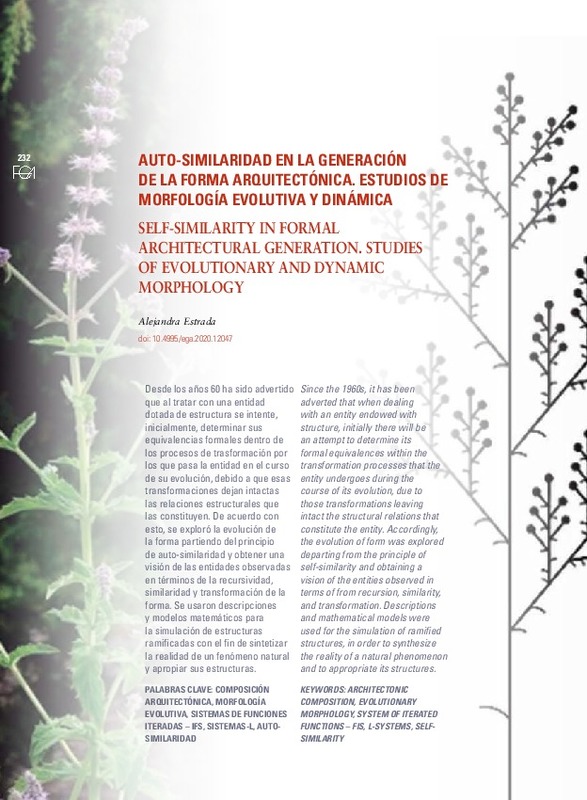JavaScript is disabled for your browser. Some features of this site may not work without it.
Buscar en RiuNet
Listar
Mi cuenta
Estadísticas
Ayuda RiuNet
Admin. UPV
Self-similarity in formal architectural generation. Studies of evolutionary and dynamic morphology
Mostrar el registro sencillo del ítem
Ficheros en el ítem
| dc.contributor.author | Estrada, Alejandra
|
es_ES |
| dc.date.accessioned | 2020-03-23T08:54:47Z | |
| dc.date.available | 2020-03-23T08:54:47Z | |
| dc.date.issued | 2020-03-13 | |
| dc.identifier.issn | 1133-6137 | |
| dc.identifier.uri | http://hdl.handle.net/10251/139164 | |
| dc.description.abstract | [ES] Desde los años 60 ha sido advertido que al tratar con una entidad dotada de estructura se intente, inicialmente, determinar sus equivalencias formales dentro de los procesos de trasformación por los que pasa la entidad en el curso de su evolución, debido a que esas transformaciones dejan intactas las relaciones estructurales que las constituyen. De acuerdo con esto, se exploró la evolución de la forma partiendo del principio de auto-similaridad y obtener una visión de las entidades observadas en términos de la recursividad, similaridad y transformación de la forma. Se usaron descripciones y modelos matemáticos para la simulación de estructuras ramificadas con el fin de sintetizar la realidad de un fenómeno natural y apropiar sus estructuras. | es_ES |
| dc.description.abstract | [EN] Since the 1960s, it has been adverted that when dealing with an entity endowed with structure, initially there will be an attempt to determine its formal equivalences within the transformation processes that the entity undergoes during the course of its evolution, due to those transformations leaving intact the structural relations that constitute the entity. Accordingly, the evolution of form was explored departing from the principle of self-similarity and obtaining a vision of the entities observed in terms of from recursion, similarity, and transformation. Descriptions and mathematical models were used for the simulation of ramified structures, in order to synthesize the reality of a natural phenomenon and to appropriate its structures. | es_ES |
| dc.language | Español | es_ES |
| dc.language | Inglés | es_ES |
| dc.publisher | Universitat Politècnica de València | es_ES |
| dc.relation.ispartof | EGA Expresión Gráfica Arquitectónica | es_ES |
| dc.rights | Reconocimiento - No comercial - Sin obra derivada (by-nc-nd) | es_ES |
| dc.subject | Architectonic composition | es_ES |
| dc.subject | Evolutionary morphology | es_ES |
| dc.subject | System of iterated functions-FIS | es_ES |
| dc.subject | L-systems | es_ES |
| dc.subject | Self-similarity | es_ES |
| dc.subject | Composición arquitectónica | es_ES |
| dc.subject | Morfología evolutiva | es_ES |
| dc.subject | Sistemas de Funciones Iteradas – IFS | es_ES |
| dc.subject | Sistemas-L | es_ES |
| dc.subject | Auto-similaridad | es_ES |
| dc.title | Self-similarity in formal architectural generation. Studies of evolutionary and dynamic morphology | es_ES |
| dc.title.alternative | Auto-similaridad en la generación de la forma arquitectónica. Estudios de morfología evolutiva y dinámica | es_ES |
| dc.type | Artículo | es_ES |
| dc.identifier.doi | 10.4995/ega.2020.12047 | |
| dc.rights.accessRights | Abierto | es_ES |
| dc.description.bibliographicCitation | Estrada, A. (2020). Self-similarity in formal architectural generation. Studies of evolutionary and dynamic morphology. EGA Expresión Gráfica Arquitectónica. 25(38):232-243. https://doi.org/10.4995/ega.2020.12047 | es_ES |
| dc.description.accrualMethod | OJS | es_ES |
| dc.relation.publisherversion | https://doi.org/10.4995/ega.2020.12047 | es_ES |
| dc.description.upvformatpinicio | 232 | es_ES |
| dc.description.upvformatpfin | 243 | es_ES |
| dc.type.version | info:eu-repo/semantics/publishedVersion | es_ES |
| dc.description.volume | 25 | es_ES |
| dc.description.issue | 38 | es_ES |
| dc.identifier.eissn | 2254-6103 | |
| dc.relation.pasarela | OJS\12047 | es_ES |
| dc.description.references | Benyus, J., 2002. Biomimicry: Innovation Inspired by Nature. Canada: HarperCollins | es_ES |
| dc.description.references | Cerrolaza, M., Shefelbine, S.J. y Garzón-Alvarado, G., 2018. Numerical Methods and Advanced Simulation in Biomechanics and Biological processes. Londres: Elsevier. | es_ES |
| dc.description.references | Crapo, M., 2011. The Alphabet and the Algorithm. MA: MIT Press. | es_ES |
| dc.description.references | Gentner, D. y Markman, A., 1996. Structure Mapping in Analogy and Similarity. American Psychologist, no. 52, pp.1-45. https://doi.org/10.1037/0003-066X.52.1.45 | es_ES |
| dc.description.references | Hallé, F., Oldeman, R. A. A. & Tomlinson, P. B., 1978. Tropical Trees and Forests. An Architectural Analysis. New York: Springer-Verlag. https://doi.org/10.1007/978-3-642-81190-6 | es_ES |
| dc.description.references | Hofstadter, D.,1982. Gödel, Escher y Bach: Una eternal trenza dorada. México: Consejo Nacional de Ciencia y Tecnología. | es_ES |
| dc.description.references | Knippers, J. y Speck, T., 2012. Design and construction principles in nature and architecture. Biomim, no.7, pp.1-10. https://doi.org/10.1088/1748-3182/7/1/015002 | es_ES |
| dc.description.references | Menges, A., 2012. Performative Morphology in architecture. Integrative Design Research, No. 5, pp.92-105. | es_ES |
| dc.description.references | Prusinkiewicz, P. y Lindenmayer, A., 2004. The Algorithmic Beauty of Plants. New York: Springer-Verlag. | es_ES |
| dc.description.references | Tversky, B., 2017. Diagrams: Cognitive foundations for design. A. Black, P. Luna, O. Lunde, y S. Walker (Eds.), Information design: Research and practice, pp.499-535. Londres: Routledge. | es_ES |
| dc.description.references | Wagner, G. P., y M. D. Laubichler., 2004. Rupert Riedl and the Re-Synthesis of Evolutionary and Developmental Biology: Body Plans and Evolvability. Journal of Experimental Zoology, no. 302, pp. 92-102. https://doi.org/10.1002/jez.b.20005 | es_ES |








